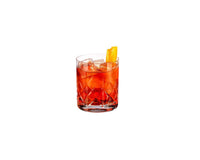Whether sweet or dry, white or red, robust or light, wine requires very specific serving procedures in order to reach its full flavor potential. In addition to proper serving temperatures, each type of wine requires a specific style of glass for service.
Anatomy of a Wine Glass
A wine glass is composed of four parts – the base, the stem, the bowl, and the rim. The base is what gives the glass its stability. From there, the stem elongates the glass while giving the customer something to hold on to without raising the temperature of the wine within. It also prevents fingerprints from getting on the bowl of the glass.
The bowl sits atop the stem. The bowl is arguably the most important feature of the glass. It should be large enough to comfortably swirl the wine without spilling or splashing it, and it should be tapered to retain and concentrate the aroma of the wine. Full-bodied red wines need room to breathe and to release their aroma.
Therefore, a larger bowl is needed when serving these wines. Conversely, white wines are typically served in smaller glasses, ones that are shaped like a "U" and narrower than a red wine glass. This gives the wine enough room for the aromas to be released but also helps in maintaining the cooler temperature of the white wines. Finally, flutes are often used to serve sparkling wines, as they help the bubbles last longer.
The uppermost part of the bowl is where the rim lies. A thinner rim is less distracting to drinkers as they sip their wine, and a smooth rim will not impede the wine as it flows from glass to mouth. Thicker, rounder rims are the sign of a cheaply made glass, and while the glasses serve their purpose, they may be more distracting to the drinker.
Red Wine Glasses
Below are the typical characteristics of a red wine glass:
• Large glass with a full, round bowl and large opening
• Opening enables you to dip your nose inside to detect the aroma
• Full bowl provides air contact for the complex aromas and flavors
• Increases the oxidation rate, which smooths out the complex flavors
White Wine Glasses
Below are the typical characteristics of a white wine glass:
• Bowl is more u-shaped and upright than a red wine glass
• Slightly smaller bowl than red wine glass
• The shape enhances and preserves aromas while also maintaining the wine's cool temperature
Dessert Wine Glasses
Below are typical characteristics of a dessert wine glass:
• Usually smaller due to the high alcohol content of dessert wines
• Dessert glasses usually also direct wine to the back to the tip and back of the mouth to allow for adequate sweetness detection
Sparkling Wine and Champagne Glasses
Below are typical characteristics of sparkling wine glasses:
• Upright, narrow bowl to preserve carbonation and flavor
Rose Wine Glasses
The best rose wine glass depends on whether you are drinking.
Flared Lip Rose Glass
Type of wine: young, crisp rose or young white wine
• Long stem ensures that heat from the hand will not warm the wine
• Flared lip directs the wine first to tip of tongue where taste buds are most sensitive to sweetness. Enhances the sweetness of crisp wine; balances flavor and minimizes any bite
Slight Taper Rose Glass
Type of wine: mature, full-bodied rose
• Short bowl that is rounded at the bottom with a slight taper instead of a flared lip
WebstaurantStore









